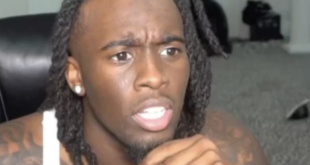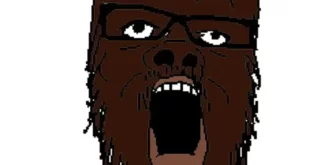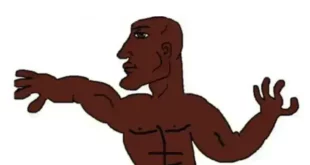Stuff Black People Don’t Like
April 5, 2015
Since the start of 2015, nine black juveniles have been shot in the St. Louis metropolitan area.
Nine. [Girl, 9, ninth juvenile victim of gun violence in St. Louis in 2015, KMOV.com, 3-31-15]
Nine black juveniles shot by fellow blacks.

Not police. Not members of the Klan. But by black people.
Only days before Easter (and a day before Good Friday), three black people would be murdered and four others shot. [3 dead, 4 injured in 4 shootings since Thursday evening in St. Louis, KMOV, 4-2-15]
And only one black person has dared to confront the rising levels of black-in-origin violence in St. Louis.
One. [‘Lone Ranger’ protester takes to the streets for the first time after St. Louis shooting, St. Louis Post-Dispatch, 3-31-15]:
The Tuesday morning protest seemed odd compared to the crush of demonstrators, reporters and activists who flocked to Ferguson.
It consisted of one Michelle Hawkins, 49, walking laps around Ray Leisure Park at Park Avenue and Tucker Boulevard. A few cars passing by during morning rush hour honked. Some drivers flashed the peace sign back at her.
“I don’t know what else to do,” Hawkins said, large tears rolling down both sides of her face. “I don’t want to live in fear, but it seems like that’s what’s it’s coming to.”
Like any day, she woke up Tuesday between 5:30 and 6 a.m. to take medication for poor circulation in her leg. The Navy veteran boiled an egg, brewed a cup of tea. She put on support stockings and walking shoes, but she felt more motivated than to just do laps around the park this time.
She’d heard all the gunfire the night before that killed a man and woman, and injured a 9-year-old girl in the hand. Hawkins, who has a grown daughter in community college, didn’t have any art supplies laying around. She went across the street from her apartment and borrowed two crayons and one sheet of yellow paper from the same rec center that serves as the city’s emergency homeless shelter during cold nights.
She drew six hearts on the paper and spelled out the word “PEACE” in large letters.
“You don’t need a big crowd to make a big shine,” she said. “The Lone Ranger made a big impact.”
She did what she thought she could do to avoid any more violence by carrying her sign.
“You know, we just spread peace one slice at a time,” she said.But there was no we.
It was just Hawkins who said she was protesting for the first time in her life.
It’s funny: back in 1961 (when St. Louis was 28 percent black), Martin Luther King addressed a black church, and he said, “Do you know that Negroes are 10 percent (sic) of the population of St. Louis and are responsible for 58% of its crimes? We’ve got to face that. And we’ve got to do something about our moral standards,” Dr. Martin Luther King Jr. told a congregation in 1961. “We know that there are many things wrong in the white world, but there are many things wrong in the black world, too. We can’t keep on blaming the white man. There are things we must do for ourselves.”
Blacks just don’t care. Blaming the “white man” is a successful tactic for blacks to immunize themselves and their community from any criticism (primarily because so many Disingenuous White Liberals will immediately concede this blame); and when you have a black President of United States of America and a black Attorney General of Department of Justice who have spent months blaming the white men of Ferguson for black people’s problems, who would even believe there is anything wrong in the black world?
Enter the black clergy, demanding jobs as a stop-gap against the black violence in St. Louis driving away jobs… [Local clergymen taking stand against gun violence in St. Louis, KMOV.com, 4-3-15]:
A recent round of shootings has prompted pastors in north St. Louis to start a plan of action to fight violent crime.
Pastors of local African American Methodist Episcopal Churches (AME) said Thursday’s three double shootings was the last straw.
“I know the Christian church does not tolerate this kind of hatred or this kind of killing. The question what are we going to do?” said Pastor Spencer L. Booker of St. Paul AME Church.
At a Good Friday service Booker announced that local AME congregations would join with other churches this summer to promote an extensive anti-violence campaign.
“It’s devastating and deadly,” said Jeffrey Boyd, the 22nd Ward Alderman. He says he knows the father of one of the shooting victims in one of the double shootings. He knows police can’t be on every street corner. The city offers recreation centers and many resources to help families and youth, but Boyd says he thinks that’s not enough.
“I guarantee you most of the violence we see in our neighborhoods, when you dig deep enough, go back to the family structure,” Boyd said.
AME church leaders say they want an effort to reduce to the number of guns in the urban core, and plan to set up GED programs. They also will be pressing business and community leaders to create jobs, but pastors say young people need to learn to respect human life.
“Respect for human life…?”
Enter The Evening Whirl, a black-run paper in St. Louis that has documented black crime and depravity for 77 years. [Inside St Louis’s lurid crime tabloid: ‘There’s a callousness about the value of life here’, The Guardian, 3-31-15]:
“Pow. Pow. Pow. Pow. Pow. That’s how three street goons came at a dude as he said goodbye to his lovely wife on the North Side last week. If that’s too much for you, pick up the Times and read the theatre reviews.”
So begins a typical article from the Evening Whirl, St Louis’s weekly print tabloid which bills itself as “an uninterrupted crime-fighting publication since 1938”. As the world’s attention fell on Ferguson last fall, the Whirl, resolutely non-digital, flew under the radar. But the paper is a St Louis institution: a 77-year-old, African American-run media enterprise that speaks to the complicated questions of race, crime and policing dogging the region today.
For those 77 years, the Evening Whirl has covered the underworld of St Louis in lurid language, cataloging crimes under headlines like “Loon Chucks Shiv at 5-0” and “Bungling Bandit Bagged and Booked”. Regular features include a column called Where Not To Be, which provides a helpful map of where readers are most likely to be murdered, and Behind the Bars, an advice column from a prisoner named Jus Bleezy, who in the latest issue calls upon readers not to flush their lives “down the drain for a chain and some street fame”.
Many articles start with a question: “WHY did a stone-cold gunslinger end a South Side squabble with slugs?” asks one query. “WHO is the con man from the womb who can steal the tighty off your whities that is being sought by North Patrol?” asks another. There are no bylines, giving it the feel of omniscient narration from an alternatively bemused and outraged voice.
You can’t find the Evening Whirl online – it is only available for $1.50 at gas stations and convenience stores. Its strongholds are the impoverished neighborhoods of St Louis proper and north St Louis County, the suburban area that includes Ferguson. The Whirl is also available across the street from the St Louis County police headquarters, where it is devoured by cops chasing gossip and leads.
“People read the Whirl because we tell it like it is,” says Anthony Sanders, the paper’s 55-year-old editor-in-chief. “If you’re a criminal and we feel that you’re a scumbag, then that’s what we call you.”
Sanders took over the Whirl in 1995 following the long tenure of Ben Thomas, an entrepreneur who founded the paper in 1938 to document St Louis’s black nightlife. Thomas soon realized he had an audience hungry for crime, and for seven decades the Whirl documented St Louis’s spiral into poverty and depravity, at times attracting national media attention.
“There is a callousness about the value of life here, period,” says Sanders. “We are among the most savage and brutal people on the face of the earth. We are killing people indiscriminately. It doesn’t always have to be gang or drug related. There are people just going off and killing people. That happens all over the country.”
Since the Ferguson protest movement began, detractors have responded with the catch-all question: “What about black-on-black crime?” It’s a question that stems from the baseless assumption that black communities do not really care about violence, or grieve their own losses. The Whirl, for all its breathless tabloid hectoring, is a rebuttal to that derailment. Its purple prose rides the line between condemnation and celebration, but its stock in trade is morality tales.
The racial angle to St. Louis’ spiral into poverty and depravity is, of course, unworthy of mentioning by anyone in polite society.
But, then again, in polite society white people must endure racial taunts as they eat their brunch…
Black Lives Don’t Matter.
They never have, and they never will.
Ferguson was a story only because it’s necessary to remove control of police departments from local hands to federal ones in Washington; and high rates of black criminality serve as a way to cleanse communities of pesky middle-class white people who would otherwise stay there for generations and work to build equity in their homes.
A community can only be created when people have a vested interest in building something permanent, and the black underclass in America has been used by the ruling class as a biological weapon to destroy whatever social capital was erected (with the founding population quickly resorting to white flight/abandonment of the city).
If a people can’t put roots down in a place, they’ll never have anything to fight for (and the black underclass, equipped with Section 8 Vouchers, represent the equivalent of the herbicide Spike 80DF when it comes to eliminating those ‘roots’ necessary for the creation of social capital), which pretty much sums up America post-1948.*
 Daily Stormer The Most Censored Publication in History
Daily Stormer The Most Censored Publication in History


